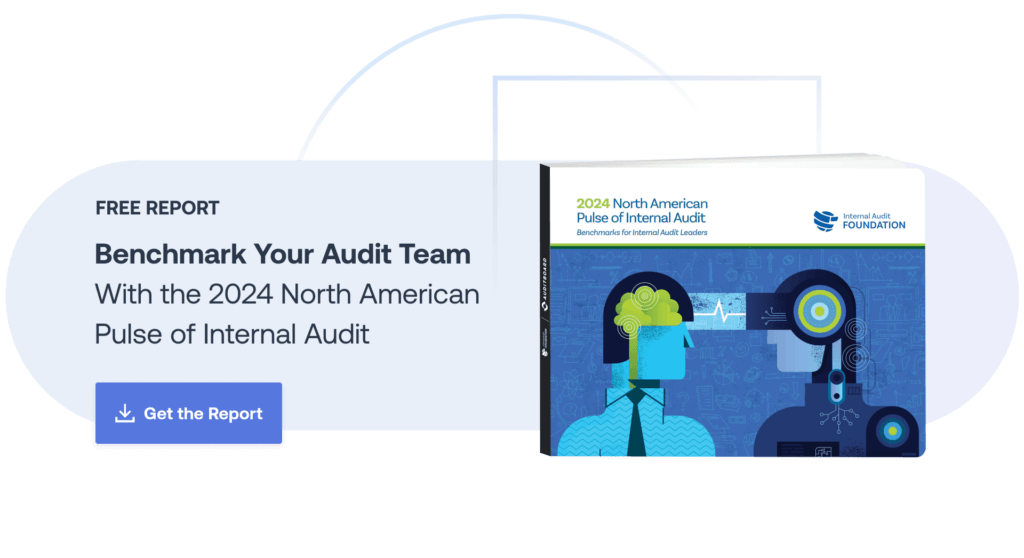
March 12, 2024 • 7 min read
2024 North American Pulse of Internal Audit: CAE Responsibility, Budget, and Staffing Trends
The internal audit profession is experiencing a steady rate of growth, reflected in budgets as well as staff growth that nearly mirrors pre-pandemic levels, The IIA’s 2024 North American Pulse Survey finds. The annual Pulse of Internal Audit report, published by The Internal Audit Foundation and co-sponsored by AuditBoard, Deloitte, and Grant Thornton, surveyed 448 internal audit CAEs and Directors in North America for insights on their internal audit activities.
The annual report, which draws on data spanning from 2008 to the present day, aims to offer insights into both present circumstances and enduring trends concerning internal audit budgets, staffing, audit plans, risk assessments, and more.
Download your copy of the 2024 North American Pulse of Internal Audit report here, and continue reading for key benchmarking metrics on CAEs, internal audit budgets, and staffing trends.
CAE Responsibilities
Eighty-four percent of CAEs have at least one area of responsibility outside of internal audit, the report finds. Fraud investigation was the most common area of additional responsibility (45%) for respondents as a whole, with the rate being much higher for privately held (64%) and public sector organizations (60%). As expected, SOX program responsibility is much higher for publicly traded organizations (69%) compared to all other organization types. Finally, responsibility for ERM programs was especially high at privately held organizations (61%).

Audit Committee Trends
The vast majority of CAEs say they attended all audit committee meetings in the past year (90%). While 40% of respondents said their audit committees meet four times per year, most organizations are increasing the frequency of audit committee meetings: more than half of audit committees meet five or more times per year, and 7% meeting every month or more.

Three Lines Model
In 2024, usage of The IIA’s Three Lines of Defense remains high among respondents, with 84% indicating their organizations take the Three Lines Model into consideration for governance. Some types of organizations are less likely to consider the Three Lines Model than average, particularly privately held organizations (68%), and organizations with internal audit functions that have 3 or fewer FTEs (69%).
Budgets Are Increasing, But Resources Are Still Lacking
Survey metrics indicate the profession of internal auditing is on a steady rate of growth in North America. After sharp cuts due to the COVID pandemic in 2020 and 2021, the percentage of functions increasing their budgets now significantly outpaces functions that are decreasing their budgets (36% vs. 13%).

Further, budget subcategories allocated for internal staffing, external staffing, and professional development have increased and stabilized since 2021.
However, despite these overall positive budget trends, 1 in 4 audit functions still feel their funding is insufficient to meet growing demands on their teams. If CAEs had access to additional funds beyond their current budgets, almost half said their top priority would be increasing in-house staff, with the second most common priority being technology (21%). This indicates that audit teams are struggling to keep pace with increasing workloads and compliance requirements with their existing resources.

Staffing Trends
The report finds more CAES increased budget than staff in 2023, a trend that is consistent with data going back to 2008, where budget increases always outpaced staff increases. However, internal audit staff growth is almost back to pre-COVID levels, a positive trend indicating that internal audit teams have bounced back from the staffing turbulence of the last few years.
A pandemic related trend that has lasted beyond 2020 is remote working: more than 70% of audit functions work remotely half the time or more. The most common remote work arrangement is a roughly equal mix of remote and in-person (39%), while 33% are completely remote. Millennial CAEs have high expectations (95%) that remote work will continue as is into the future, which sheds light on the future of internal audit recruiting and staffing trends.
Recruiting Challenges and Opportunities
Twenty-nine percent of CAEs say they have hired a recent college graduate. Larger internal audit functions are much more likely to hire recent college graduates compared to functions with less than 25 on staff. Smaller functions may not have structure in place to onboard inexperienced new employees while maintaining needed services.
Compensation is a common recruiting challenge, chosen by 29% of respondents, but many other issues are also impactful, the survey finds. More than two-thirds of respondents significantly grapple with recruiting challenges including lack of competencies, too few applicants, or lack of internal audit experience needed. This sheds light on the serious issue of ongoing skills and talent shortages in the internal audit profession. Without addressing these areas by focusing on upskilling staff, improving benefits and compensation, and investing in cutting-edge technologies, organizations may find it hard to remain competitive in the internal audit talent market in the coming years.
For the full 2024 Pulse of Internal Audit report, download your free copy here.
You may also like to read


Effective planning in permacrisis requires unified, collaborative risk leadership

Fraud triangle: A practical guide for internal audit teams

HR audit process: A practical guide to streamline compliance and risk

Effective planning in permacrisis requires unified, collaborative risk leadership

Fraud triangle: A practical guide for internal audit teams
Discover why industry leaders choose AuditBoard
SCHEDULE A DEMO




